How To Focus A Camera At Night
How to Focus your Camera For Astrophotography
Whether you're using a photographic camera lens or a telescope, learning how to focus your photographic camera for an astrophotography image is one of the offset big hurdles to overcome when inbound this hobby.
In this article, I'll discuss the methods I apply to focus my telescopes and lenses for astrophotography, and the photographic camera settings that make the unabridged process easier.
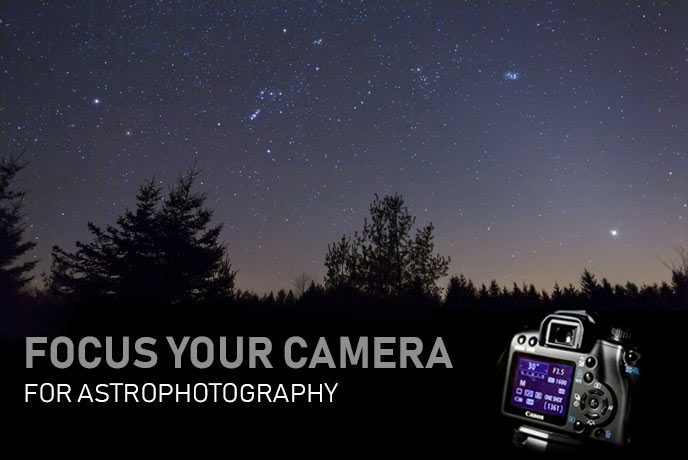
In astrophotography, the magnification and calibration of your image will vary widely depending on the optical instrument used. Sometimes, you want to capture a massive area of the dark sky such as the core of the Galaxy. Other times, nosotros focus on pocket-size nebulae and galaxies for a closer look.
No matter what the focal length of your photographic camera lens or telescope is, your focus must be spot-on for a sharp image. Achieving a tight focus on your subject is important in all areas of astrophotography, from pictures of the moon and planets to wide-bending photos of the Milky Way.
Depending on the optics and photographic camera used, this experience may get a challenging chore. Lenses with fast eyes (F/2 or below) tend to be the most challenging to focus, as they can exist very demanding in terms of reaching disquisitional focus.
At that place are certain situations where you lot may not want to exist in focus on the night sky, but these are creative shots that can exist explored afterward on. Learning how to focus your camera for astrophotography properly is an essential step of the hobby.
Related: vii Essential Astrophotography Tips and Camera Settings
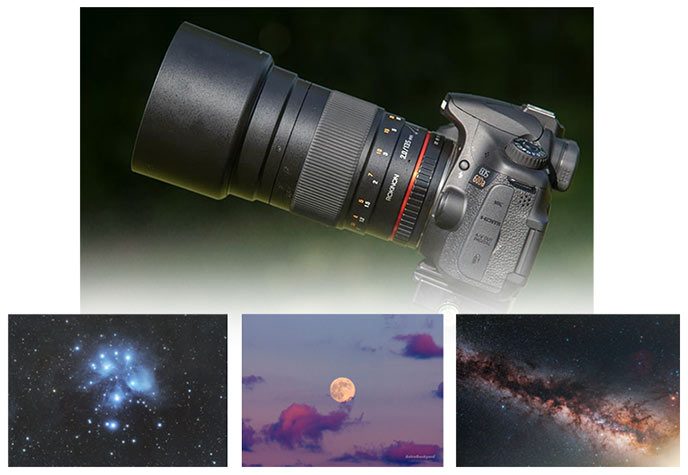
Using a Photographic camera Lens
If yous're using a photographic camera lens, it needs to be on transmission focus (MF) mode, equally the stars are likewise dim and too minor for the camera to use autofocus on. Autofocusing a lens or telescope for astrophotography is possible, merely requires some additional hardware and software (more on this beneath).
Taking the time to focus your camera lens is vitally of import, as an out-of-focus shot is unrecoverable. Camera noise and slight star trailing tin can be corrected and subconscious to an extent, an unfocused shot cannot. At that place is something nigh dark photography that causes people to rush their setup (often to maximize fourth dimension under a clear heaven), nonetheless a hasty setup routine oft results in disappointment.
To focus your photographic camera lens, detect the brightest star y'all tin can find in the nighttime sky (or the moon/vivid planet). Turn on the "live-view" mode of your camera, which substantially turns the display screen into a live video of what your sensor sees.

The moon, planets, and vivid stars are useful when focusing your photographic camera.
It is possible to achieve a useful, rough focus your DSLR or mirrorless camera using the viewfinder, but you'll definitely want to fine-tune it using the cameras large LCD display screen.
With the right camera settings, you should meet at least one bright star on your camera's LCD display screen.
Y'all can also use a manmade light source like a afar streetlamp, but an actual star is best. Information technology's important to retrieve that the settings you utilise to focus the lens are not the same 1 you'll apply for the actual image.
Camera Settings for Focusing the Lens:
- Mode: Manual or Bulb
- Lens Way: Manual Focus
- Aperture: F/4 or below (every bit depression as it goes)
- White Balance: Daylight or Auto
- Exposure: 30-seconds or Seedling
- ISO: 1600 or above (Higher will show more than stars)
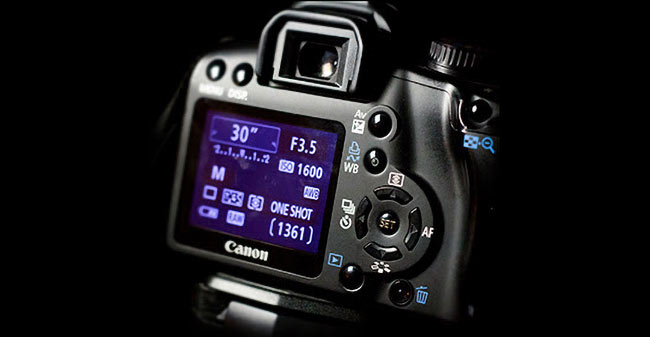
The reason you'll desire to apply these exaggerated settings us to let equally much possible light achieve the sensor equally possible. Some of the brightest stars in the northern hemisphere to assistance you focus include Sirius, Vega, Deneb, Altair, Arcturus. These stars are all bright plenty to see in your live-view display to assist you focus your lens or telescope.
If you are certain that your camera lens is pointed towards a bright star, and still see a completely black screen, ensure the following scenarios are not present:
- The lens cap is still on your lens (have it off)
- Y'all are not using exaggerated camera settings for maximum light (adjust ISO, exposure, and f-stop)
- The lens is and so out of focus (rack focus in and out and wait for the star)
It's piece of cake to forget to accommodate the lens back to your "shooting" settings later focusing. Fifty-fifty if you lot have every setting right, but have accidentally set your aperture to F/22, you lot won't see a single star.
The lens shown below, (Rokinon 135mm F/ii) uses a manual "click" discontinuity ring to adjust the f-terminate. Using this lens "wide open" at F/ii makes focusing very easy because enough of light is collected while in live-view manner. All the same, this lens performs improve with a less aggressive aperture (F/three.2), and then you must remember to modify the aperture setting after focusing the lens.
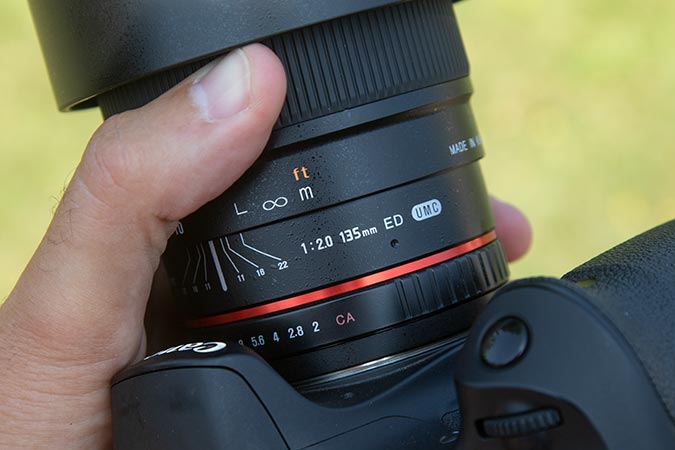
One time yous do meet the star in on the photographic camera'due south display screen, zoom in on it, at 5X zoom, and then 10X zoom. The digital zoom is making the picture on your display screen bigger, the lens has not changed the magnification. While in 10X zoom fashion, slowly accommodate the focuser on your lens until the star becomes a modest pinpoint of light.
You will have to get dorsum and forth, in and out of focus many times before you find the spot where the pinpoint is smallest and sharpest.
You tin can take examination exposures and compare your results to ostend the stars in the image are as pocket-size as possible. At present, the tricky part is retaining this focus equally you move your photographic camera lens or telescope to your subject area.
Y'all might get lucky and choose a subject that includes a bright star in the field as was the case for this photo of the California Nebula. Run into that star to the right of NGC 1499? That'southward Atik, and it was vivid plenty to see in the alive-view display of my Canon 60Da.

The California Nebula in Perseus. DLSR camera and Rokinon 135mm F/ii Lens.
If you're using a telescope on a tracking mount, your focus likely won't budge when you movement to your target. If you're using a camera lens, yet, it's very easy to knock the helical focuser out of position when moving the photographic camera.
Avert grasping the barrel of your lens when positioning the camera (tape tin can be effective). If you change the focus slightly by fault, it's normally non far off and tin can be fine-tuned with a few test shots on your subject.
Using a Telescope
When it comes to astrophotography, telescopes are oftentimes easier to focus than camera lenses. This is simply because telescopes usually have precision, robust focusers that lock into place. A camera lens designed for daytime photography, on the other paw, was meant to move quickly to accurately focus on moving subjects.
To focus a telescope with a camera attached, you only demand to turn the focuser knob until your subject comes into view. Nigh of the telescopes amateurs use for astrophotography (Here are the ones I recommend) will have dual-speed, 10-1 focusers, and the ability to lock the focuser in place.
beingness able to lock the focuser in identify is extremely valuable. When the telescope is pointed at certain angles (like direct upwards), the weight of your camera equipment tin can exist enough for the focuser to "autumn" out of position over time. The telescope pictured below is an fantabulous option in this regard, every bit the focuser on the William Optics Zenithstar 73 is robust, smooth, and locks.
In the photo below, you lot can see the camera fastened to the stop of the focuser drawtube, and focus is achieved by turning the focus knob to move the drawtube in and out. In contrast, a camera lens uses a helical style focusing band.
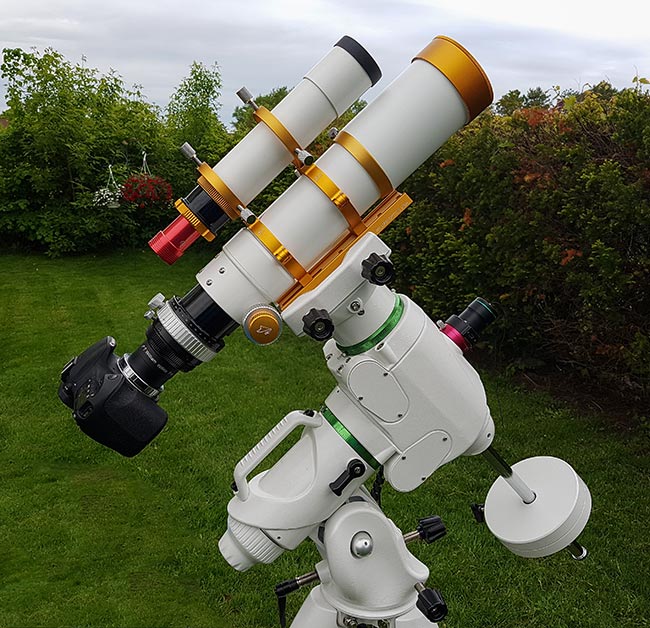
A typical astrophotography telescope setup with a dual-speed (Crayford-style) focuser.
Y'all'll likely notice it easier to focus a refractor telescope on a brilliant star than a camera lens. The focuser moves much slower, and you'll make several rotations of the focuser knob rather than the small turns of a camera lens focus band.
Telescopes with "fast" optics such as the Celestron RASA (F/2) are more demanding on focus accuracy just can let in a lot of light in a brusk period of fourth dimension. Many of the apochromatic refractor telescopes I accept used are in the range of F/vi – F/7 and are capable of capturing images with extremely sharp details of your discipline.
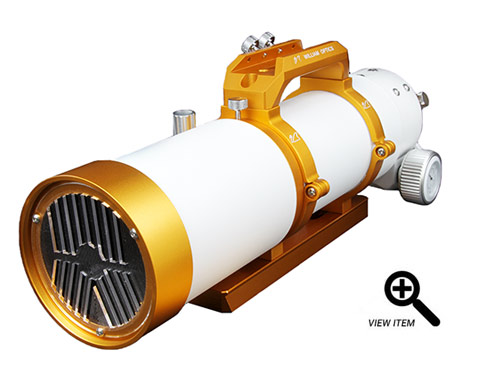
Focusing on the Moon and Planets
The same process of using the 5-10X live view applies when photographing the moon or the planets. The divergence this fourth dimension is that the subject is very bright, and less aggressive camera settings must be used.
I recommend dialing dorsum your ISO and exposure settings so that the face of the moon is non over-exposed, and y'all can run across the mid-tones of the surface. Once y'all have institute a rough focus on the moon, yous tin can zoom in to wait at information technology at 5X and 10X magnification.
Information technology is not uncommon to see a lot of turbulence (that looks like rippling waves of air) betwixt your optics and the surface of the moon at high magnification.
Now, you lot should first to meet the rocky surface of the moon come up into focus and it is but a thing of adjusting the focus until information technology is as sharp as possible. You tin can also use the moon to focus your lens or telescope before hopping over to a much dimmer target in the nighttime sky.

A sharp photo of the moon captured with a Canon 300mm F/4L telephoto lens.
Changes in Temperature
Because astrophotography takes place at dark, you often feel a drop in temperature between the time yous gear up your camera, and when night sets in. Always take extra time to focus your camera properly, and go on to monitor focus throughout the night. Every bit the ambient temperature changes, your focus does too.
If y'all simply focus the camera once and leave it in that position for an unabridged night of imaging, you may observe that your shots gradually became unfocused over fourth dimension. This tin can be a painful and unexpected experience, so do yourself a favor and check your focus a few times throughout your imaging session.
When the fourth dimension comes to stack and annals a series of images, you'll only want to stack the subframes with the sharpest focus into your final picture. Stacking software such every bit DeepSkyStacker can provide you with a "score" for each of your exposures, and the level of sharpness of the stars in the prototype is a big contributing gene.
If your focus becomes worse over time, you should see the scores gradually drop. This usually indicates that a change in temperature afflicted your focus.
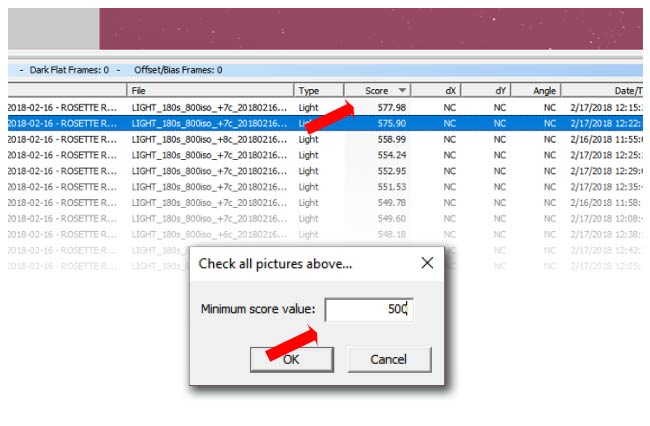
DeepSkyStacker can score the quality (and sharpness) of your astrophotos.
Use a Bahtinov Mask
A Bahtinov mask is a handy tool to use when focusing your camera for astrophotography. This simple accompaniment sits in front of the photographic camera lens or telescope objective to create a star diffraction design. The pattern helps you reach critical focus past creating an "X" blueprint with a central bar that you lot must place in the center.
To utilize a Bahtinov mask you must point your camera towards a brilliant star in the nighttime sky. Y'all volition as well need to employ the "wide open" settings for focusing mentioned earlier to maximize low-cal transmission.
Every bit you adjust the focuser of your telescope or lens, the central spike in the pattern will motility in and out of the X blueprint. When the fundamental spike is sitting directly centered between the X, your camera is in focus.
I regularly use a Bahtinov mask to focus my telescopes. In the image below, you'll run across the pattern you are looking to replicate with the Bahtinov mask in identify.

Use the star diffraction pattern created past a Bahtinov mask to attain focus.
Some of the telescopes I use for astrophotography include a built-in mask within of the lens cap. The William Optics RedCat 51 is i example, and I utilise this tool to focus my camera each and every time.
William Optics feels strongly about this blueprint and includes it as a built-in feature for nigh of their refractors. The compact Z61 doublet refractor (shown below) is a popular choice for broad-field deep-sky imaging with a DSLR camera.

The articulate, acrylic version y'all run into on the telescopes in a higher place (William Eyes "Star Spikes" focus mask) allows fifty-fifty more than light to pass through to the photographic camera sensor and can make focusing the telescope a little easier.
You can too purchase Bahtinov masks or about whatsoever size for your lens or telescope. The production below was designed to fit inside of a 58mm DSLR camera lens filter.

What about Autofocus?
In the world of astrophotography, autofocus can simply be done with a combination of software and a motorized focuser. This is because a reading of the star size (FWHM or HFD) must be made and practical to your lens or telescope in real-time.
Photographic camera automation software such as Astro Photography Tool tin read the subtle changes in the size of a star, and apply micro-adjustments to your telescope or camera lens' position.
Advanced imagers rely on motorized focusers to maintain critical focus on their subject over long periods of time. Some users even re-focus their telescope after each exposure is taken.
If you are taking 2-three-infinitesimal exposures or less with a DSLR camera, this would exist overkill. However, for apprentice astrophotographers taking x-infinitesimal long exposures with a CCD camera, this makes a lot of sense.

A motorized focuser fastened to the Celestron RASA 8 for precise focusing at F/2.
Applied Insights from Amateur Astrophotographers
I asked the AstroBackyard Facebook page if they had any additional tips for focusing their camera at night for astrophotography. As usual, the amateur astrophotography customs offered a number of helpful focusing tips.
"I am a big proponent of bahtinov masks and even more then for automated focusers using the FWHM method. With those focusers, I usually refocus every hr and on filter changes, since I use a mono camera. For long imaging nights, this allows me to focus without me even being present. Unfortunately, I have non even so found a good way to focus on the sun…"
- Michael Abraham
"Focus to hyperfocal distance, or a few centimeters by it. Downside is, hyperfocal changes with the focal length and discontinuity. In this example, apps such equally PhotoPills are great help.
But lacking that, I resort to the live view zoom technique."
- Carlos PhotoCage
"When using long focal lengths and manual focusing I notice it all-time to focus on a very brilliant star that has a non so brilliant companion. For case my personal favourite is Acrux. Use the bright star (Acrux A) for focusing, with live view enabled and zoomed in as much as possible showing both stars. In one case it is in focus you will discover the fainter star (Acrux B ) that is otherwise hardly visible volition beginning to 'pop'. This happens merely in the very narrow infinite where y'all take achieved actual focus."
- Steffen Boelaars
"Here's another tip. Marking your focuser tube with a sharpie. Mine has "25mm" and "Nikon" lines that make it easy to get quickly about focus. Of course this works all-time if your tube isn't black."
- George L Poston
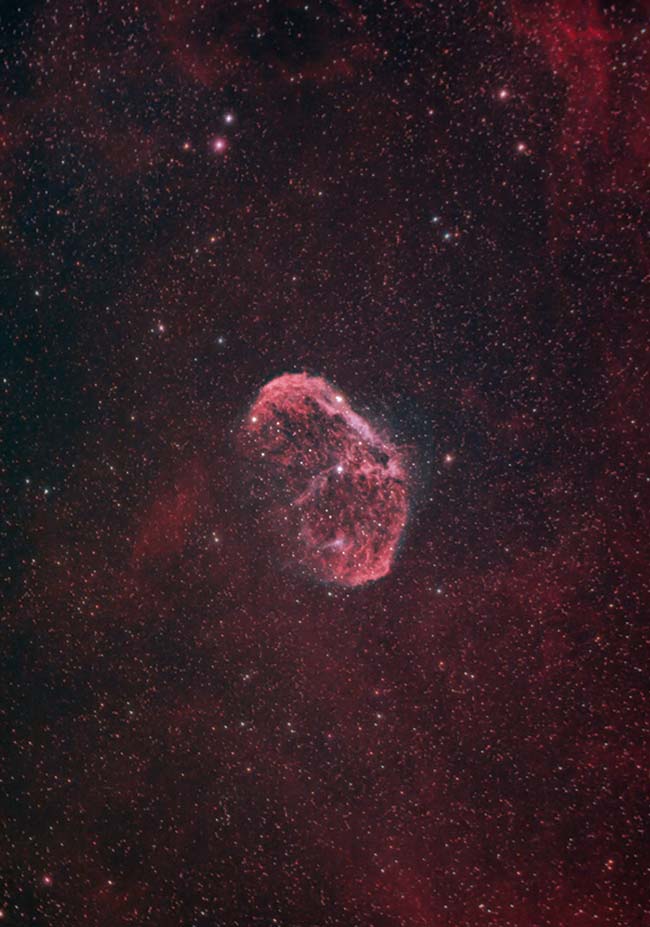
I used a Bahtinov Mask to reach focus on a bright star before capturing this prototype of the Crescent Nebula.
Final Thoughts
The main takeaway I would similar you to remember is that is e'er worth your time and endeavor to really fine-tune the focus of your photographic camera. When it comes to long exposure astrophotography, we often get defenseless upwardly in collecting the maximum amount of exposure time possible while the sky is clear. Still, collecting multiple sub-exposures with out-of-focus stars is of no value to your last projection.
Don't obsess about re-focusing your camera every five minutes either. Unless there has been a major drop in temperature, your focus should remain relatively unchanged for an hr or more. I tend to check the focus of my shots near two-iii times throughout an imaging session.
Sometimes, the conditions can affect the clarity of your photos, and soften or bloat the stars in your moving-picture show. A thin brume of clouds will brand an image that is in-focus appear soft and blurry, simply in that location is nothing you can do well-nigh that.

The results of your focus efforts will exist rewarded when reviewing your long exposure images in post.
Related Posts:
- Perfect Wide-Angle Camera Lens for Astrophotography: Rokinon 14mm F/2.8
- White Residuum Settings for Astrophotography
- Remove Dust and Vignetting with Flat-Field Frames

Source: https://astrobackyard.com/how-to-focus-astrophotography/
Posted by: johnwasion.blogspot.com

0 Response to "How To Focus A Camera At Night"
Post a Comment